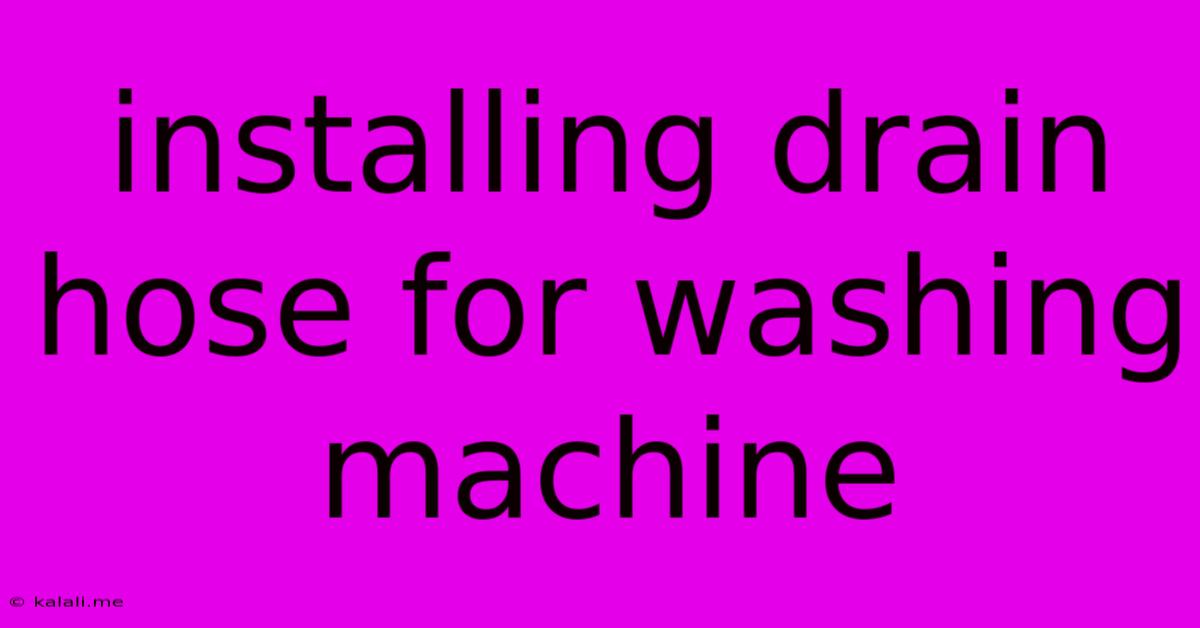Installing Drain Hose For Washing Machine
Kalali
May 30, 2025 · 4 min read

Table of Contents
Installing a Washing Machine Drain Hose: A Step-by-Step Guide
Meta Description: Learn how to properly install your washing machine drain hose to prevent leaks and ensure efficient operation. This step-by-step guide covers everything from choosing the right hose to securing it safely.
Installing a washing machine drain hose might seem daunting, but it's a straightforward process that anyone can manage with a little patience and the right tools. A properly installed drain hose is crucial for preventing leaks and ensuring your washing machine operates smoothly and efficiently. This guide will walk you through every step, from selecting the appropriate hose to securing it to prevent any plumbing mishaps.
Choosing the Right Drain Hose
Before you begin, ensure you have the correct drain hose for your washing machine. Most machines come with a standard drain hose, but it's always a good idea to check the specifications in your machine's manual. Consider these factors:
- Length: The hose needs to reach from the back of your washing machine to your drainpipe, with some extra slack to allow for movement. A hose that's too short can strain connections, leading to leaks. A hose that's excessively long can create siphoning issues.
- Diameter: Check your washing machine's specifications for the correct diameter. Using an incompatible hose can affect water drainage efficiency.
- Material: Most drain hoses are made of durable, flexible PVC. Ensure yours is in good condition – no cracks or kinks – before installation.
Tools You'll Need
To install your washing machine drain hose, gather these essential tools:
- Adjustable Wrench: For tightening connections.
- Pliers (optional): Can help with securing clamps.
- Screwdriver (if necessary): Some drainpipe configurations might require unscrewing existing components.
- Bucket or Towels: To catch any spills during installation.
Step-by-Step Installation Process
1. Preparing the Drainpipe:
- Locate your standpipe or laundry tub drain. This is usually a vertical pipe designed specifically for washing machine drainage. It should be located near your washing machine.
- Important Note: Never connect your drain hose directly to a floor drain, as this can lead to siphoning issues and potentially back up wastewater into your machine.
2. Connecting the Drain Hose:
- Securely attach the drain hose to the washing machine's drain outlet. This connection is usually a simple push-fit system. Refer to your washing machine's manual for specific instructions.
- Route the hose: Carefully guide the drain hose from the back of the washing machine towards the drainpipe. Avoid sharp bends or kinks that might restrict water flow. Ensure the hose is high enough to prevent siphoning. The ideal height is above the water level in the standpipe.
3. Securing the Drain Hose to the Drainpipe:
-
There are two common methods for connecting the drain hose to the drainpipe:
- Standpipe Connection: Most standpipes have a slip-on connection. Simply slide the drain hose onto the standpipe opening, ensuring it's securely fitted. If it has a retaining clip, ensure this is properly engaged.
- Laundry Tub Connection: If you're using a laundry tub drain, you'll typically use a drain hose adapter or a hook-over type of attachment. Again, refer to your washing machine's manual and ensure the connection is secure and leak-free.
4. Checking for Leaks:
- Once the hose is securely connected, run a test wash cycle. Carefully monitor all connections for any leaks. If you notice any leaks, immediately stop the cycle, and re-tighten or adjust the connections as needed.
5. Secure the Hose:
- To keep the hose neatly in place, use a hose clamp or zip ties to secure it to the wall, preventing the hose from dangling. This prevents accidental disconnections and keeps everything organized.
Troubleshooting Common Issues:
- Slow drainage: This often points to a kink in the hose or a clog in the drainpipe.
- Leaks: Ensure all connections are tight and the hose isn't damaged. Check for any cracks or holes.
- Siphoning: The drain hose must be positioned above the water level in the standpipe to prevent siphoning issues.
By following these steps and paying attention to the details, you can confidently install your washing machine drain hose and avoid potential plumbing problems. Remember to always consult your washing machine's manual for specific instructions and recommendations.
Latest Posts
Latest Posts
-
The Making And Authorized Distribution Of This Film Supported Over
May 31, 2025
-
How To Get Foil Off Bottom Of Oven
May 31, 2025
-
How To Vent A Portable Air Conditioner
May 31, 2025
-
Whats A Spell In Magic The Gathering
May 31, 2025
-
How To Remove Toilet Lock Nut
May 31, 2025
Related Post
Thank you for visiting our website which covers about Installing Drain Hose For Washing Machine . We hope the information provided has been useful to you. Feel free to contact us if you have any questions or need further assistance. See you next time and don't miss to bookmark.